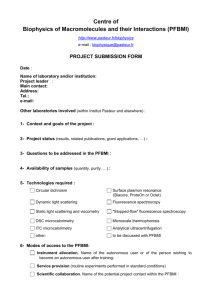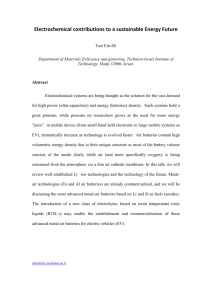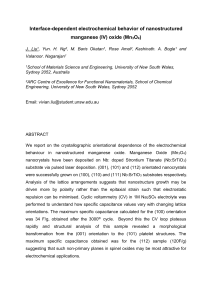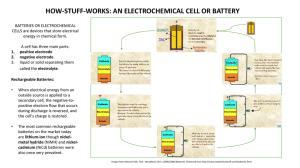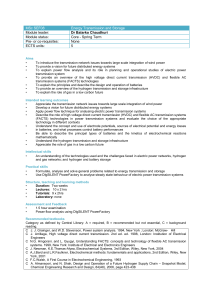microcalorimtry for studying the Electrolyte stability
advertisement
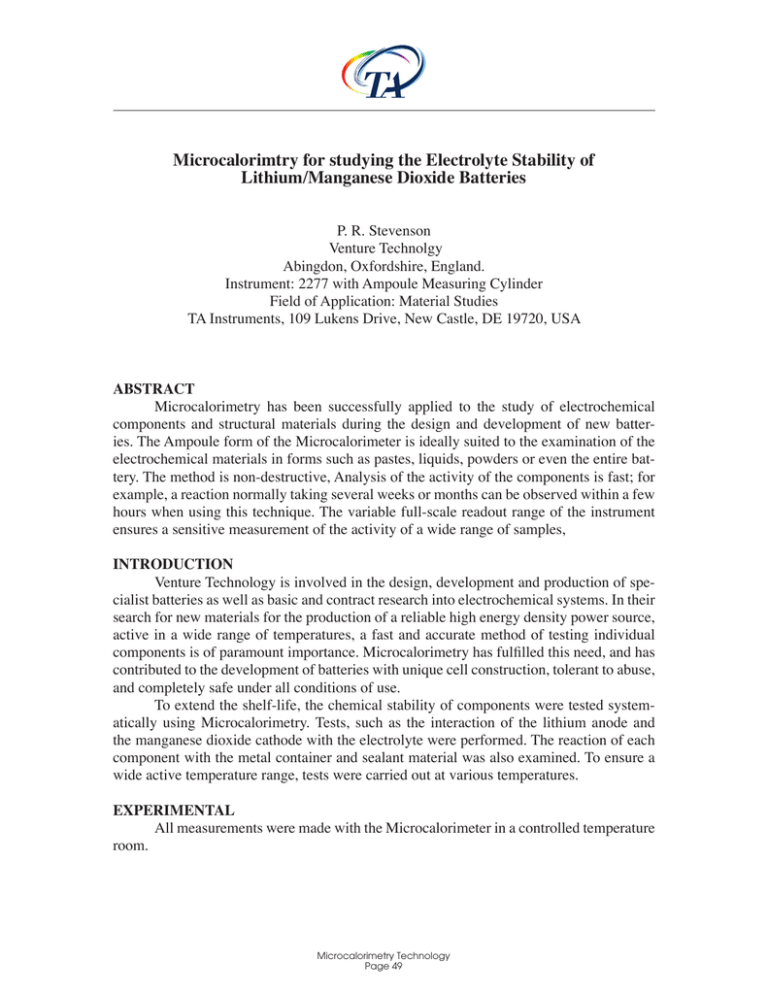
Microcalorimtry for studying the Electrolyte Stability of Lithium/Manganese Dioxide Batteries P. R. Stevenson Venture Technolgy Abingdon, Oxfordshire, England. Instrument: 2277 with Ampoule Measuring Cylinder Field of Application: Material Studies TA Instruments, 109 Lukens Drive, New Castle, DE 19720, USA ABSTRACT Microcalorimetry has been successfully applied to the study of electrochemical components and structural materials during the design and development of new batteries. The Ampoule form of the Microcalorimeter is ideally suited to the examination of the electrochemical materials in forms such as pastes, liquids, powders or even the entire battery. The method is non-destructive, Analysis of the activity of the components is fast; for example, a reaction normally taking several weeks or months can be observed within a few hours when using this technique. The variable full-scale readout range of the instrument ensures a sensitive measurement of the activity of a wide range of samples, INTRODUCTION Venture Technology is involved in the design, development and production of specialist batteries as well as basic and contract research into electrochemical systems. In their search for new materials for the production of a reliable high energy density power source, active in a wide range of temperatures, a fast and accurate method of testing individual components is of paramount importance. Microcalorimetry has fulfilled this need, and has contributed to the development of batteries with unique cell construction, tolerant to abuse, and completely safe under all conditions of use. To extend the shelf-life, the chemical stability of components were tested systematically using Microcalorimetry. Tests, such as the interaction of the lithium anode and the manganese dioxide cathode with the electrolyte were performed. The reaction of each component with the metal container and sealant material was also examined. To ensure a wide active temperature range, tests were carried out at various temperatures. EXPERIMENTAL All measurements were made with the Microcalorimeter in a controlled temperature room. Microcalorimetry Technology Page 49 1. Lithium Manganese Dioxide 3V cylindrical cell at 70 °C. The cell was suspended from a steel loop spot-welded on to the case. The cell was held in a plastic tube so that the assembly was the same height as the LKB ampoule. This ensured that the suspension loop was disengaged from the lowering hook during the recording period. Blank runs have shown that after an initial annealing period at 70 °C the presence of the plastic tube produces no more than a one microwatt inaccuracy in measurements. 2. 0.175 g Manganese Dioxide and 0.404 g Propylene Carbonate at 70°C. The Manganese Dioxide and Propylene Carbonate were combined in a dry box with a moisture content of less than 50 ppm. The mixture was hermetically sealed in a glass ampoule drawn from a glass test tube. This ampoule was then placed in a LKB stainless steel ampoule before lowering into the Microcalorimeter. Microcalorimetry Technology Page 50 3. 0.012 g Lithium and 0.56 g Propylene Carbonate at 70°C. The components were sealed together in the same way as in experiment 2. The rate of heat production was much lower though, and a more sensitive calorimeter range was used. These three experiments illustrate the comparative instability of the Manganese Dioxide/Propylene Carbonate combination. It is therefore in this area that we are concentrating our efforts to improve the high temperature stability of our cells. DISCUSSION Microcalorimetry has proved to be an effective tool in the study of the electrochemical components of batteries. Other techniques commonly used in studies of this type, have some serious drawbacks. Gas chromatography, for example, although frequently used, can produce inaccurate results because of the need to take the samples during the reaction process. The method is also cumbersome, inconvenient and time-consuming. Spectroscopy too is difficult, since the electrode-electrolyte combination is heterogeneous. Microcalorimetry provides a direct, non-destructive method where the activity of the electrochemical components can be measured for stability and compatibility. The analysis is fast so the stability and thus the shelf-life can be predicted in a matter of hours. With the lowest detectable limit at 0.15 /µW, a shelf-life prediction can be made on even the most inactive components. At the same time the variable full-scale readout range allows for samples with activity as high as 3000 µW to be studied. Furthermore, the ability of the equipment to take measurements in the range 20 °C—80 °C assists in the identification of electrolytes and components suitable for use in batteries with a wide active temperature range. In the future, Microcalorimetry will, without doubt, continue to be a valuable technique for the assessment of components and products in this industry. It is anticipated that the use of Microcalorimetry will be extended to quality control of the raw materials for production and to stability testing for production control of the finished product. With continued use in research, Microcalorimetry will undoubtedly help to increase our knowledge of the electrochemical systems in use, and will provide the firm scientific basis for new battery designs. Microcalorimetry Technology Page 51
